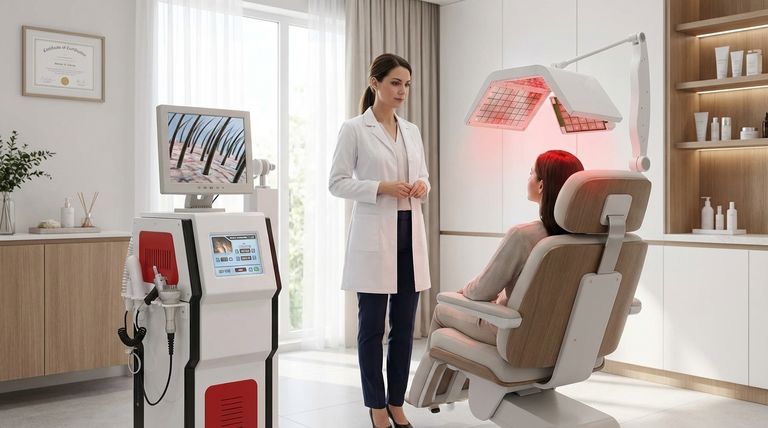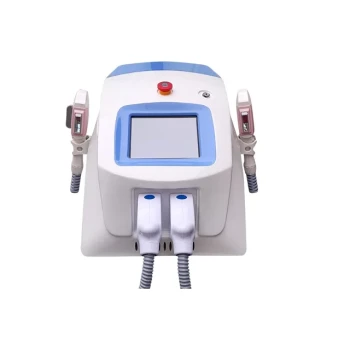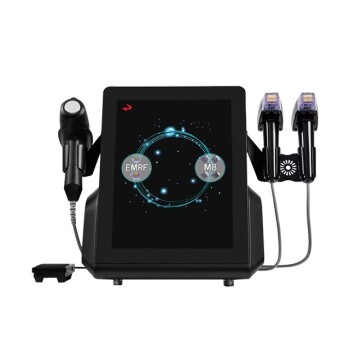Based on the available research, a low-frequency electromagnetic field (EMF) of 50 Hz has been shown to be beneficial for hair growth and wound healing. This specific frequency appears to stimulate biological activity at a cellular level, promoting a healthier environment for hair follicles.
The central takeaway is not simply the number "50 Hz," but the underlying technology it represents: low-frequency electromagnetic field (EMF) therapy. Understanding the mechanism and the state of the science is critical before considering it as a viable option for hair loss.

How EMF Influences Hair Follicles
To understand why a specific frequency is studied, we first need to grasp the core concept of how electromagnetic fields interact with the body.
Defining Electromagnetic Fields (EMF)
EMF is a type of energy that surrounds us. Low-frequency fields, like the 50 Hz signal used in power lines and some therapeutic devices, are non-ionizing, meaning they don't carry enough energy to damage DNA directly.
Instead, they are thought to interact with the body's own electrical and chemical signals.
The Proposed Mechanism for Growth
The primary theory is that 50 Hz EMF helps stimulate cellular activity. It may enhance blood flow to the scalp, delivering more oxygen and nutrients to the hair follicles.
This process is similar to how EMF is used to promote the healing of wounds and bone fractures. By creating a more robust and active cellular environment, it supports the natural growth cycle of the hair.
Why the 50 Hz Frequency is Significant
The 50 Hz frequency is one of the most common and well-studied frequencies globally, as it is used for AC power grids in many countries.
This widespread presence means its biological effects have been the subject of extensive research, making it a logical starting point for therapeutic applications like stimulating hair growth.
Understanding the Scientific Context
While promising, it's crucial to view these findings within the broader scientific landscape. A single data point is an indicator, not a final conclusion.
The Supporting Evidence
The research cited strongly suggests a positive link between 50 Hz EMF exposure and the functional recovery of hair follicles. This provides a solid foundation for its potential as a non-invasive treatment.
The Need for Broader Confirmation
However, the scientific standard requires multiple, large-scale, and peer-reviewed studies to confirm these initial findings. The broader medical community has not yet adopted EMF as a mainstream treatment for hair loss.
More research is needed to determine optimal treatment durations, power levels, and long-term effectiveness across different types of hair loss.
Key Considerations and Trade-offs
Before exploring any treatment, it is vital to understand the potential variables and pitfalls. The effectiveness of any technology is dependent on its proper application.
Professional vs. At-Home Devices
There is a significant difference between the calibrated, high-precision equipment used in clinical studies and the at-home devices available to consumers. The results seen in a lab may not be reproducible with a commercial product.
Diagnosis Is a Prerequisite
Hair loss has numerous root causes, including genetics, hormonal changes, nutritional deficiencies, and stress. EMF therapy may not address the underlying reason for your specific condition.
A proper diagnosis from a dermatologist or trichologist is the most critical first step. Applying a treatment without understanding the cause can lead to lost time and money.
Making an Informed Decision
Your approach should be guided by your ultimate goal, whether that's exploring new technology or finding the most reliable current solution.
- If your primary focus is exploring novel treatments: You can research clinical trials or specialists in bio-electromagnetic therapies to see if this technology is an appropriate option for you.
- If your primary focus is addressing hair loss effectively: Start by consulting a medical professional to diagnose the root cause and discuss scientifically-proven treatments like Minoxidil, Finasteride, or PRP therapy.
- If your primary focus is evaluating at-home devices: Prioritize products that have been cleared by regulatory bodies (like the FDA) and are transparent about the technology they use and the evidence supporting their claims.
Ultimately, understanding the principles behind a treatment empowers you to ask the right questions and make the best choice for your personal health.
Summary Table:
| Key Aspect | Details |
|---|---|
| Studied Frequency | 50 Hz (Low-Frequency Electromagnetic Field) |
| Proposed Mechanism | Stimulates cellular activity & blood flow to nourish hair follicles |
| Clinical Support | Promising research, but not yet a mainstream, universally adopted treatment |
| Primary Consideration | A professional diagnosis for the root cause of hair loss is essential first step |
Ready to integrate professional-grade technology into your practice?
BELIS specializes in providing advanced, reliable medical aesthetic equipment for clinics and premium beauty salons. Ensure your treatments are backed by precise, professional technology.
Contact our experts today to discuss the best solutions for your business and client needs.
Visual Guide

Related Products
- Multifunctional Laser Hair Growth Machine Device for Hair Growth
- Multifunctional Laser Hair Growth Machine Device for Hair Growth
- IPL SHR+Radio frecuency machine
- RF Microneedling Machine Micro Needle Radio Frequency Machine
- Clinic Diode Laser Hair Removal Machine with SHR and Trilaser Technology
People Also Ask
- How often should you do laser hair regrowth? A Guide to the Two-Phase Treatment Schedule
- How effective is LLLT for hair? Clinically Proven to Boost Hair Growth by 35%
- Are IPL machines safe? Understanding Skin Tone Compatibility for Safe At-Home Use
- Do laser caps really regrow hair? A Science-Backed Guide to Effective Hair Regrowth
- What does the SHR do? The Gentle, Pain-Free Revolution in Laser Hair Removal



















